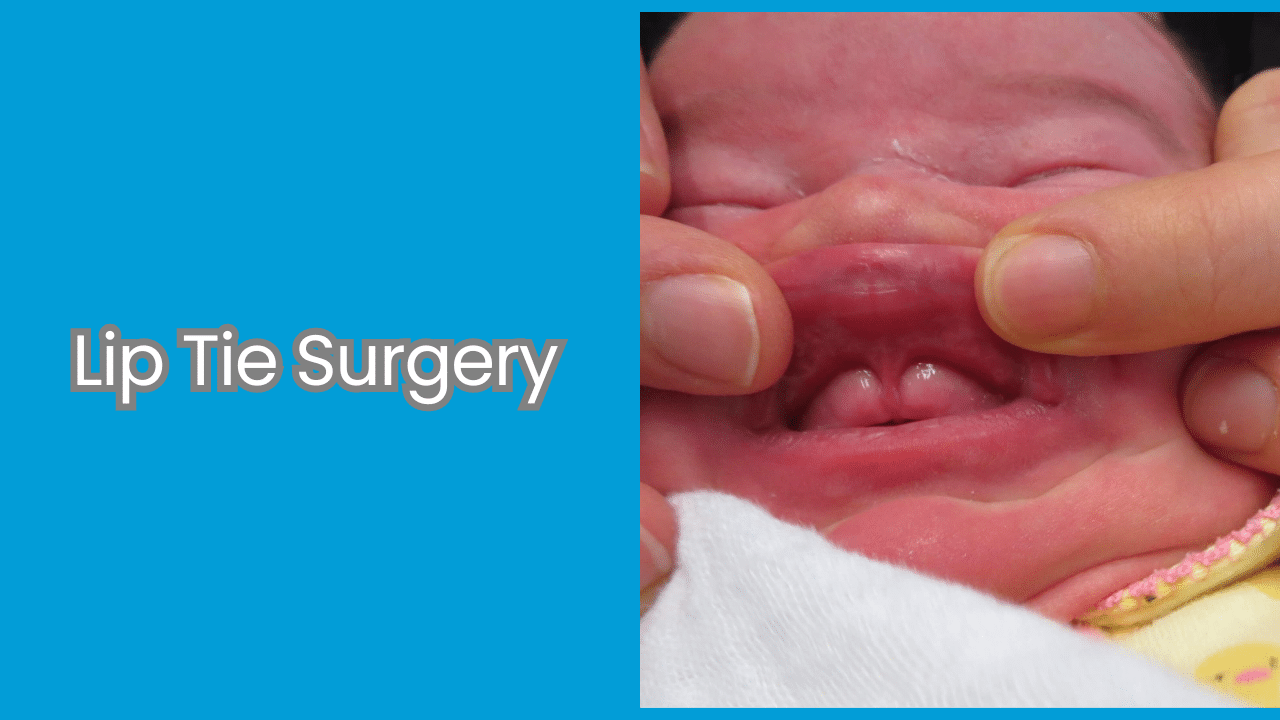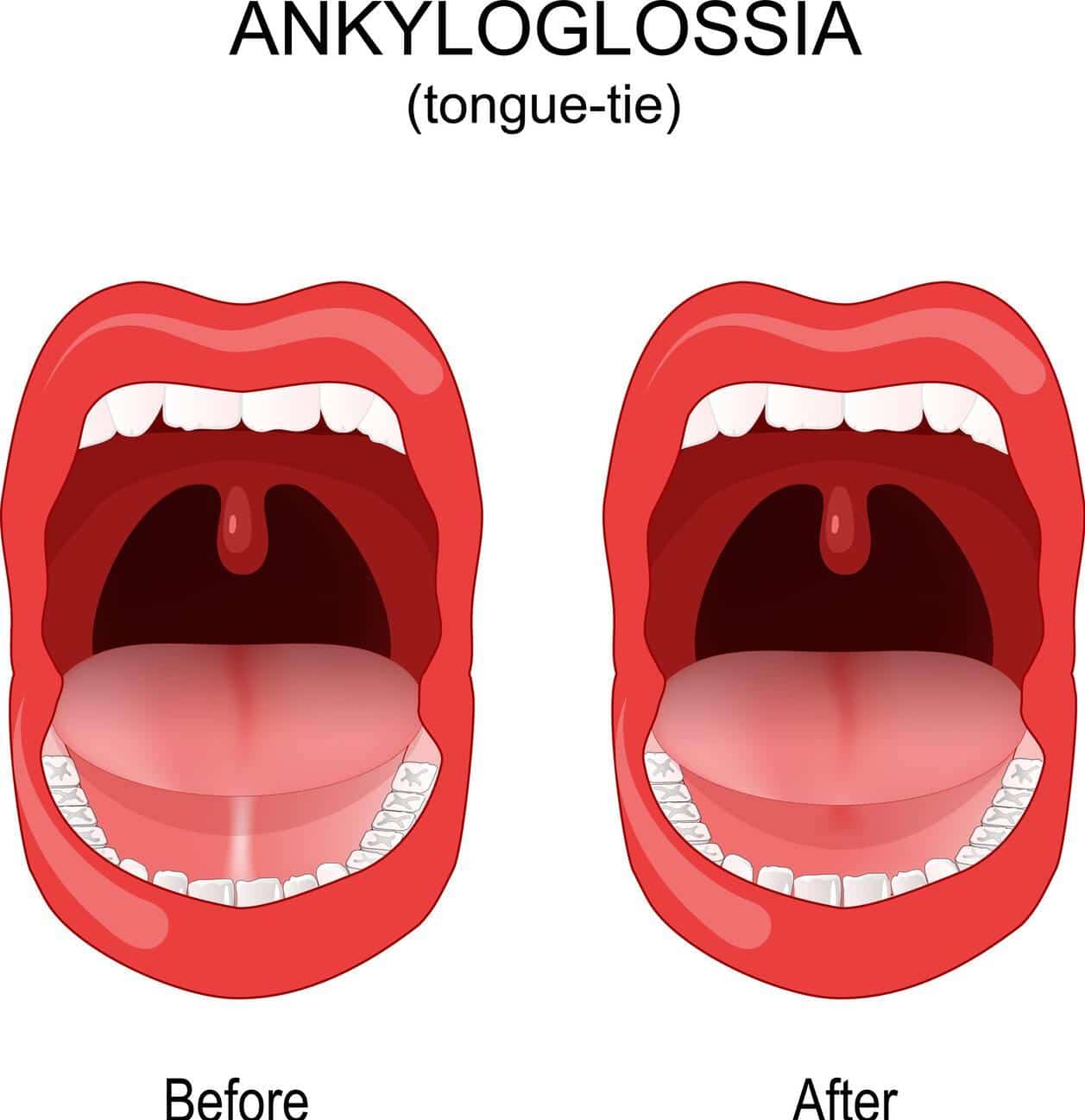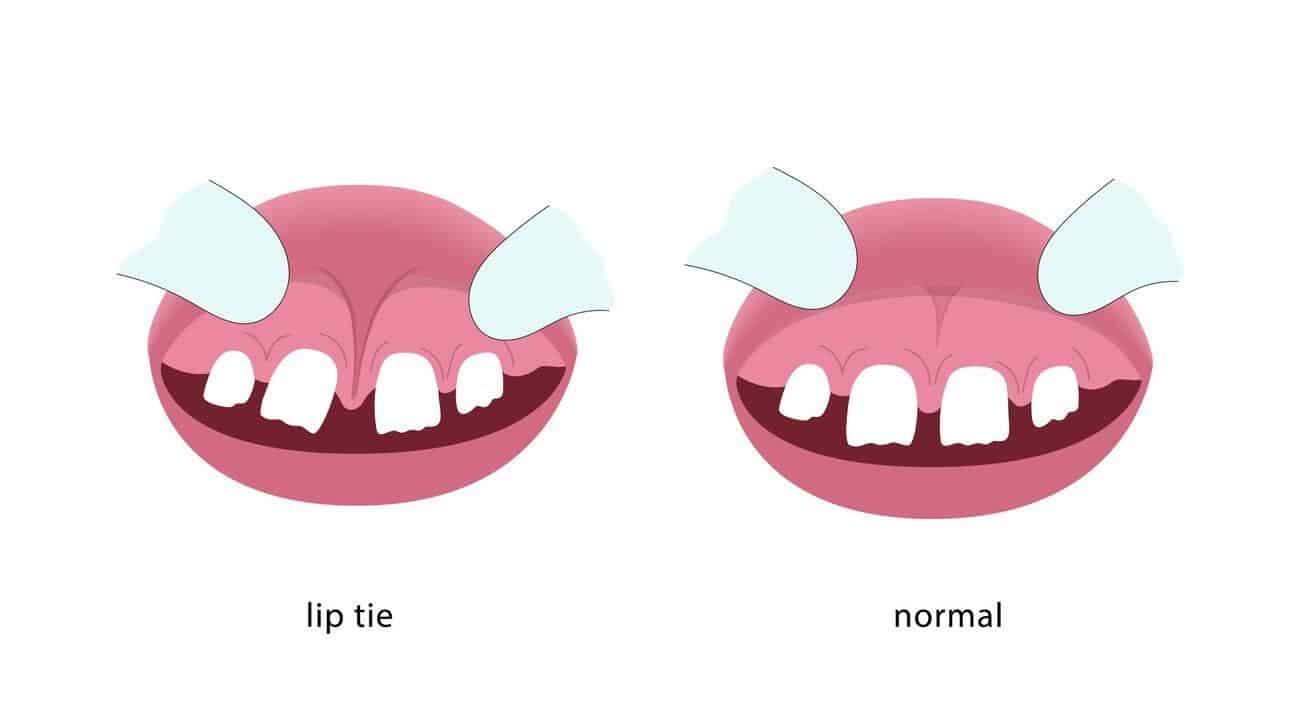Are you or your little one dealing with feeding, speech development, and dental health challenges? If so, it is possible that lip-tie may be the underlying cause. Lip tie occurs when a band of tissue known as the frenum restricts movement of the upper lip.
In this article, we’ll provide an overview of what a lip tie is and how to identify it, as well as review treatment options such as laser frenectomy surgery and post-operative care.
Here you will find all the information needed to understand lip tie surgery for making informed decisions about your healthcare needs. Let’s get started!
Content Highlights
- Lip tie occurs when a band of tissue known as the frenum restricts movement of the upper lip.
- Tongue and lip ties can cause issues such as difficulties breastfeeding, poor speech development, and dental health problems.
- Treatment options for tongue and lip ties include traditional or laser frenectomy surgeries, which take place under local anaesthesia.
- After a successful procedure, postoperative care involves pain management and oral hygiene regimens to ensure proper healing.
Understanding Tongue-Tie and Lip-Tie
A tongue-tie and a lip-tie occur when the muscles of the tongue or lips are restricted in movement due to a tight frenulum. So it is best to learn about both conditions, their possible symptoms, and ways they can affect your child’s health.
What Is a Frenulum?
A frenulum is a thin piece of tissue connecting two different parts of the body, such as the lips and gums or the tongue and floor of the mouth. It helps control movement within these areas for everyday functions like eating, drinking, speaking, and other activities requiring coordination.
A healthy frenulum provides necessary support so that when an action requires movement in two directions simultaneously, it will happen with ease – like licking your lips or sticking out your tongue.
When this band of connective tissue is too long or short, it can cause adverse health conditions that may require medical attention. An abnormally tight high frenum can cause serious issues in babies during breastfeeding by restricting nursing due to improper latching, which could lead to fussiness at feeding time and/or poor weight gain from insufficient milk intake.
What Is a Tongue Tie?
A tongue tie, also known as ankyloglossia, is a condition caused by tissue connecting the bottom of the tongue to the floor of the mouth that is too short or too tight. This can make it difficult for an individual to lift their tongue normally and open their lower jaw with a full range of motion.
As a result, problems may arise in breastfeeding due to inadequate latch formation, difficulties with speech production due to inaccurate pronunciation of certain sounds and vocal reflections, mostly at vowel level articulations, and risks of dental issues relating to malocclusion.
Tongue ties can affect people of all ages; infants may experience difficulty latching on when breastfeeding, while adults have trouble eating food items such as steak or corn on the cob due to a lack of lateral movement within their jaw joints.
What Is a Lip Tie?
A lip tie is an extra short or tight labial frenulum that connects a baby’s upper lip to its gum. This can cause problems with breastfeeding, speech development, and dental health if not addressed.
Lip ties can affect the ability of a newborn to latch onto the nipple properly which can lead to difficulty in sucking milk from the breast for proper nutrition. A lip-tie may also interfere with tongue movement needed for normal speech production resulting in difficulty articulating words.
Dental hygiene may also be affected as it may prohibit regular flossing and brushing of teeth due to improper positioning of lips and cheeks when putting oral care items into the mouth.
Diagnosis usually involves a physical examination by a healthcare professional or lactation consultant, followed by treatment options such as traditional frenectomy or laser frenectomy if required.
Laser Frenectomy offers many benefits, including minimal invasiveness, precision accuracy, fast healing time along less pain compared to other methods although the benefit has yet to be proven through clinical studies.
Symptoms and Effects on Feeding
In cases of tongue-tie and lip-tie, the frenulum (or small fold of tissue) that connects under a baby’s mouth can be too short or tight. This restrictive movement affects the baby’s ability to latch on properly during feeding, and it can lead to difficulties in breastfeeding or bottle feeding.
Common symptoms include difficulty latching, poor weight gain, clicking noises during nursing sessions, pain for both infant and parent while attempting to feed, as well as gassiness due to the baby’s inability to move their jaws correctly.
Poorly managed tongue-tie and lip-ties have been linked with several health complications for babies in early childhood, such as poorly developed speech patterns like unclear speech production or limited vocabulary.
Bottle-fed babies may also suffer from gas pains due to sudden changes in milk sucked from nipple bottles resulting from restricted tongues’ insertion abilities into nipples, making them troublesome drinkers.
How Tongue-Tie and Lip-Tie Can Affect Your Child
[Video Credits @PedsDocTalk TV]
Read more to understand the effects of tongue and lip tie on nursing, dental health, and speech development.
Breastfeeding Complications
The presence of tongue-tie or lip-tie can have a significant impact on breastfeeding. The connection between the breast and the infant’s mouth can be disrupted due to these conditions, leading to pain, swelling, tenderness, and difficulty with oral care for both the mother and baby.
This disruption may cause an incomplete seal during latching on, reducing milk flow and cutting nursing sessions short. Other related issues include compression of milk ducts or nipples, which can increase discomfort or even lead to infection in severe cases.
Fortunately, frenectomies are available as a treatment option that may help reduce symptoms associated with tongue-tie and lip-tie while also improving feeding outcomes. A frenectomy refers to the partial removal of tissue known as the frenulum; in infants, this is typically done through snipping techniques using either surgical scissors or scalpel blades though laser treatments are also an option.
Lingual (underneath the tongue) frenectomy removes or modifies tissue connecting to the undersides of tongues, whereas labial (the front part inside) frenectomy aims at removing tissues connecting gums from front teeth. Both interventions thus aim at providing infants with improved accessibility for arms when it comes to feeding sessions.
Speech Development Issues
Tongue-tie and lip-tie can profoundly negatively affect speech development in young children. Limited or restricted mobility of the tongue, resulting from forms of these conditions, can directly affect articulation as well as enunciation.
This may result in difficulties when it comes to producing certain sounds, such as hard consonants like ‘th’ or soft consonants like ‘s.’ It is not uncommon for a child with an unusually tight frenum to produce abnormally lisped speech, making certain words difficult to understand or recognize.
In addition to this, limited movement due to tongue-tie or lip-tie can also cause difficulty with properly forming vowels and other necessary components of speech communication, such as rhythm and intonation.
In order to address these issues at hand, traditional frenectomies are often used—a process that involves surgically removing part (and sometimes all) of a subject’s frenulum if it is deemed too short or tight, effectively freeing up tongue and/or lip movement.
Dental Health Concerns
The potential oral health concerns associated with tongue-tie and lip-tie issues can range from gum recession to pain in the mouth when eating or talking. These effects on dental health often become more obvious as a child ages, so it is important to address probable implications early on through diagnostic testing and assessment.
Frenectomy, which involves removing or modifying the affected tissue that connects the underside of the tongue to the floor of the mouth (lingual frenectomy) or between upper gums to front teeth (labial frenectomies), may be recommended for infants who are experiencing difficulties with feeding or speech development.
Adults may also require this procedure if too much tension within a frenum pulls away at their gums, causing sensitivity and discomfort around their teeth. Laser frenectomy offers a minimally invasive alternative due to its precision and accuracy while still being fast and ultimately less painful than other treatment options.
Read Also: Everything You Need To Know About Buck Teeth
Diagnosis of Tongue-Tie and Lip-Tie
A physical examination, along with an assessment by a lactation consultant, is required to diagnose and identify tongue-tie or lip-tie properly.
Physical Examination
A physical examination is used to diagnose tongue-tie and lip-tie in infants and adults. During the examination, a healthcare professional will carefully observe the frena – or bands of tissue – connecting the upper lip to the gums above it, as well as any attachments between the underside of the tongue and the floor of the mouth.
The physician will assess if these connections are too short or too tight, which can cause complications such as difficulty with breastfeeding or speech impediments.
Additionally, a physical examination may be necessary for diagnosing oral health problems, like gum recession or Gum and Teeth pain caused by dental malocclusion.
Furthermore, since proper feeding mechanics can directly affect speech development, it is important for physicians to identify any issues that may exist through careful observation during a physical assessment.
Assessment By a Lactation Consultant
A lactation consultant plays an important role in the assessment of tongue-tie and lip-tie. This expert can help provide valuable insights into potential feeding issues related to these conditions and speech concerns that may be causing difficulties.
The lactation consultant will typically perform a physical examination to check for any signs or presence of tongue-ties and lip ties. They will also consider any other factors that could be impacting your child’s feeding or speech development, such as birth trauma, position during birth, dental health, or structural differences within the mouth.
A lactation consultant’s evaluation is crucial for detecting tongue and lip tie problems. These issues can lead to breastfeeding difficulties, like ineffective attachment and milk transfer, and hinder a baby’s development in tasks such as sticking out their tongue or chewing. They can also cause tissue damage due to pacifier use, speech problems, slow growth, nutrition deficiencies, and teething delays.
A thorough assessment by experienced specialists who are skilled in early infant diagnosis is essential for diagnosing, treating, and preventing more serious problems that might otherwise go unnoticed without regular care.
Treatment Options for Tongue-Tie and Lip-Tie
Treatment options may include a traditional frenectomy procedure or a more minimally invasive laser frenectomy, depending on the severity and symptoms of tongue-tie or lip-tie.
Traditional Frenectomy
A traditional frenectomy is a type of oral surgery used to treat tongue-tie and lip-tie in babies or children. This procedure involves the surgical removal of tissue from the surface of the lips, gums, or tongue that prevents proper movement or function.
A traditional frenectomy aims to improve breastfeeding problems, speech development deficits, dental health issues due to gum recession, and pain associated with brushing or other oral care.
During a traditional frenectomy, local anesthesia is administered, and small pieces are cut with sharp scissors. Recovery time can vary depending on each individual patient, but it typically takes several weeks for healing as normal tissue regrowth occurs at the surgical sites.
Related Article: What Happens if Frenectomy Procedure Goes Wrong.
Laser Frenectomy
Laser frenectomy is a minimally invasive type of oral surgery that is used to treat both lip-tie and tongue-tie. It involves using a specialized laser device to cut the frenulum, which is the tissue connecting your upper or lower lip to your gums or tongue respectively.
This procedure reduces restrictions on movement in these areas and can help alleviate issues with breastfeeding, speech development, dental health, and more. The laser allows for precise targeting of tissues without damaging nearby structures such as teeth or gums.
Additionally, it requires little healing time compared to traditional surgical techniques since there’s no open wound left behind after the procedure. This allows patients with either condition the ability to go back to their everyday activities quickly and without discomfort once the procedure has been completed successfully by their medical team.
The Benefits of Laser Frenectomy
Laser technology offers numerous advantages over traditional surgery, including minimal invasiveness, greater precision and accuracy of cutting tissues, and less pain for the infant or child patient.
Minimally Invasive
Lip Tie surgery is a type of oral procedure that can be used to treat issues such as lip tie and tongue tie. During the treatment, a minimally invasive frenectomy is performed, which involves removing or loosening tissue called the frenulum which helps link the gums, lips, and tongue together.
This type of procedure offers numerous advantages over traditional methods as it requires only small incisions instead of extensive trimming. As a result, these treatments are significantly less painful for patients with typically shorter recovery times than other alternative options.
The increased range of motion in the tongue and potential improvements in dental alignment are two benefits offered by this type of procedure since an increased amount of flexibility may lead to better latching ability when breastfeeding or improved speaking capabilities among children who were previously developing speech delays due to poor function in their mouth area.
Precise and Accurate
Laser frenectomy procedures for tongue-tie and lip-tie are known for their precision and accuracy. This surgical technique has a number of advantages over traditional methods, such as minimally invasiveness, reduced risk of tissue damage, minimal bleeding, and fast recovery times.
The laser is able to precisely target the excess tissue and remove it without interfering with or damaging surrounding tissues. Additionally, this procedure allows much faster healing times due to its minimal invasiveness compared to traditional techniques, which require cutting through healthy tissue in order to access the areas needing repair.
When properly conducted, these qualities of laser technology in frenotomy treatments coupled with expertise clinically experienced healthcare providers can provide far better outcomes than traditional methods with fewer complications while dramatically reducing discomfort during surgery and the aftercare process!
Fast and Painless
A frenectomy is a relatively fast and painless procedure that takes only minutes to complete. This minimally invasive surgery removes the tissue in the mouth, known as a frenum, which attaches the gum or lip to surrounding tissues like teeth or bone.
Typically, local anesthesia is used before the procedure, and laser technology is employed for accuracy and speed while minimizing discomfort. Thanks to this modern technology, many patients do not need pre-or post-operative care, with most people feeling little more than minor discomfort after undergoing treatment.
The purpose of a frenectomy is primarily corrective; it can resolve pain from tongue ties or make breastfeeding easier when an infant has difficulty latching due to tight labial ties or lip ties.
When performed around orthodontic appliances such as braces, it may assist in loosening tight contacts between neighboring teeth during tooth movement while also helping prevent gum recession or periodontal disease.
It can even help restore freedom of mouth movement for adults with difficulty opening their mouths wide enough due to scar tissue buildup caused by past injuries, radiation therapy treatments, surgical procedures, and other events impacting facial nerves.
Post-Operative Care After Tongue-Tie And Lip-Tie Surgery
It’s important to take proper care of the surgical site and surrounding tissue in order to achieve optimal healing following a tongue-tie or lip-tie procedure.
What to Expect After the Procedure
After a lip tie procedure, patients may experience pain, swelling, and tenderness in their affected area. Pain is usually managed with medication; it’s important to follow instructions provided by the doctor for managing discomfort.
Avoiding certain activities or foods that can irritate the surgical site while healing can aid in recovery. It’s common to initially have some mild bleeding or oozing from the surgical area, but this should subside within a few days.
However, it should be reported to your doctor immediately if severe bleeding persists. Healing time varies from patient to patient; most will notice an improvement after about one week but full healing may take up to two weeks as inflammation and discomfort decreases over time.
Tips for Aiding In Healing
After a lip tie procedure, there are certain measures that can be taken to promote healing and relieve any discomfort. Pain relievers may be needed for the first few days post-surgery to help ease discomfort.
Your doctor or specialist should provide you with complete postoperative instructions on how to aid in the healing process, such as gently cleaning the area after feeding or light massage of your baby’s lips multiple times daily.
Some health professionals have also recommended antibacterial mouthwashes for promoting proper healing after lip tie surgery. It is important not to skip any necessary steps in caring for your baby’s lips following their surgery as it could cause complications down the line from slow healing or infection.
Follow-Up Appointments
Follow-up appointments after a frenectomy procedure are highly recommended to ensure proper healing. During these appointments, the doctor will monitor your child’s progress and address any concerns or complications that may arise following the surgery.
The time between each appointment will depend on your child’s age and situation. Postoperative instructions should be discussed during these appointments to help progress toward proper healing, such as preventing infection and bleeding post-surgery.
These follow-up visits are no less important, even if your infant can resume feeding immediately after surgery is completed; this is responsible for ensuring long-term success with regard to speech development and dental health, which otherwise could be negatively impacted if tongue tie or lip tie issues go unaddressed over time.
Collaborative Approach to Treatment
A comprehensive approach to lip-tie treatment involves consulting specialists from various fields, including dentists, speech-language pathologists, and lactation consultants, to ensure your child’s best outcome.
Importance of Collaboration Between Specialists
Collaboration among specialists is essential for comprehensive treatment and understanding of lip tie surgery. Patients benefit from the complementary skillsets of oral health professionals, speech pathologists, surgeons, and midwives when it comes to optimizing outcomes after a frenectomy.
By working together, they can ensure that short- and long-term effects resulting from tongue ties or lip ties are addressed holistically, reducing current and potential complications during breastfeeding or speech development.
The collaborative approach taken by healthcare providers helps them make accurate assessments when considering which procedure (traditional frenectomy vs laser frenectomy) might be best for the patient’s particular situation – such as if a baby requires anesthetic before a minor surgical procedure.
Furthermore, based on their training in both clinical with patients, such as in lactation support and research studies to maintain up-to-date knowledge regarding available resources or interview protocols needing to explore other options before proceeding – professionals will also be able to determine the right timing for the flap division procedure before any serious consequent defects occur due to prolonged tethering of labia fold structures.
Shared Decision-Making Process
The shared decision-making process for the treatment of tongue-tie and lip-tie surgery is an interactive process between a healthcare provider and the patient’s family that combines clinical evidence with the family’s values, preferences, and situations to determine which procedure is right for them.
This collaborative approach involves both parties discussing treatment options, risks, and benefits associated with each option available. It must also consider the family’s unique circumstances, such as parenting style or medical history.
The healthcare professional will provide guidance on which procedure might be best suited based on the evaluation of all factors combined, but ultimately, it is up to the family to make their own decision in line with their values and beliefs.
It is important for families to have information regarding potential outcomes from techniques used before making a choice so that they can fully understand any risks involved and decide what works best for them without feeling rushed or pressured into making a hasty decision.
What to Expect From a Lip Tie Procedure
[Video Credits @Soroush Zaghi, MD]
Learn about the definition, purpose, and steps of lip tie surgery and how to aid in the recovery process for optimal results.
Definition and Purpose
A lip tie surgery, also known as a frenectomy, is a surgical procedure used to correct the attachment of tissue connecting two organs. Frena are bands of connective tissue which in this situation, join the lips to the gums or the tongue to the floor of the mouth.
By undergoing a frenectomy, it can be possible to increase the tongue’s range of motion or close gaps between teeth. Such surgery mainly aims to treat conditions affecting feeding, speech, and dental health in babies and adults alike.
Correcting a lip tie can be a helpful solution for breastfeeding issues. It can address problems like difficulty latching on and positioning during feeds caused by the restriction it creates. This restriction makes it tough for moms to express milk fully, leading to issues like nipple damage from forceful pulls when trying to unlatch or feed slowly.
Additionally, this condition can be linked to developmental delays and dental health problems. Some studies even suggest a higher risk of certain umbilical disorders.
Lip tie correction techniques are notably effective in reducing pain and improving breastfeeding. This can greatly enhance a mother’s well-being. However, it’s important for parents to discuss their options and potential risks with a healthcare professional before considering the procedure.
Steps of the Surgery
A lip tie procedure is a minor surgery performed to release the frenulum, which is the connective tissue that connects the upper or lower lip with the gum. The goal of this procedure is to improve feeding and/or speech development by allowing better movement of the lips during these activities.
Local anesthesia will be injected into the area before making an incision in order to reduce any pain or discomfort felt during this operation. After safely cutting away all unnecessary attachments, any bleeding can then be easily controlled with suturing if necessary.
Finally, depending on the patient’s age group and medical history, post-operative care instruction should always come along for future recovery guidelines as per the doctor’s recommendations.
Recovery and Results
The recovery time after undergoing a lip tie procedure varies, depending on the age of the person who had surgery. For infants, it is common for them to resume feeding immediately after the procedure.
Older children and adults can expect about three to five days of recovery time. During this period, side effects such as swelling or minor pain may occur; however, these should ease with rest and proper care after surgery.
It’s important for patients to follow their healthcare provider’s postoperative instructions carefully in order to ensure optimal healing and speed up recovery times.
The benefits that come from a successful frenectomy include improved breastfeeding issues (such as sore nipples) along with speech improvements by correcting tongue movements needed during sound production.
Frequently Asked Questions (FAQs)
To find answers to commonly asked questions, please read our FAQ section.
1. What Is Lip Tie Surgery?
Lip tie surgery, also known as frenectomy, is a surgical procedure that removes or releases excess tissue from the labial frenulum which connects the upper lip to the gums.
2. Is Lip Tie Surgery Safe?
Yes, when performed by a qualified surgeon in sterile conditions lip tie surgery is generally considered safe and effective.
3. Who Performs Lip Tie Surgeries?
Lip tie surgeries are typically performed by dentists or oral surgeons who have experience with this kind of procedure on infants and children.
4 . What Are The Risks of Having Lip Tie Surgery?
The most common risks associated with lip tie surgery include infection at the incision site, bleeding, difficulty breastfeeding, and some pain during and after the procedure.
5 . How Should I Prepare for My Baby’s Tie Surgery?
It’s important to talk to your doctor or dentist about your operative care before they undergo slip-tie treatments so you can follow their specific instructions regarding preparation for surgery, including no drinking surveyed foods beforehand.










































